Spending three weeks on the back of a bike exploring Vietnam’s most famous destinations as well as the much lesser-traveled backroads and rural villages exposed a side of the country that most travelers don’t see.
I met the kindest locals and experienced breathtaking views with not another soul in sight (or in my pictures). Best of all, the complete freedom of whipping down a highway in an unfamiliar land is probably the most exciting feeling ever.
If you’re heading to Vietnam and are ready for an epic adventure, this guide will tell you everything you need to know.
Preparing your motorbike trip
Starting point
You can start your motorbike trip in Hanoi (in the north) and finish in Ho Chi Minh (the south) or vice versa.
Picking a northern or southern starting point and terminating in the opposite city means you can make an efficient route plan and the driving will be straightforward – literally. Much of the driving is done on the same highway.
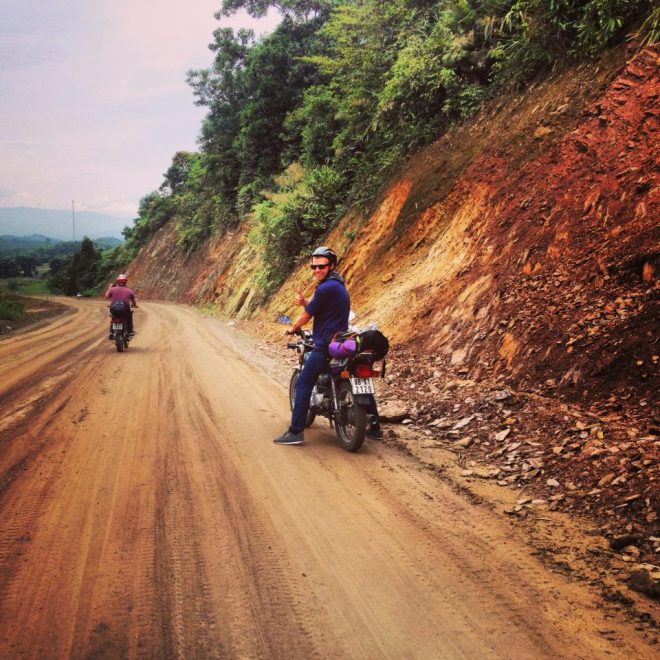
Finding your crew
You can make this trip solo, but it’s advisable to get yourself at least one buddy.
Finding someone to join you on this journey shouldn’t be too difficult. Hang around the hostels and spread the word. You may find someone who hadn’t planned to motorbike Vietnam at all and convince them – that’s how I got roped in!
My new friends told me about their plans, asked me to join, and the next day we were on our way…
Scoring a motorbike
Once you’ve got your road buddies, it’s time to decide on a bike. There are two options for getting a bike in Vietnam; you can either buy or rent.
Buying a motorbike in Vietnam: Buying a second-hand (fourth-hand is actually more like it) bike from another traveler who has just finished the same journey you’re about to embark on is the most common way to go.
Hanoi and Ho Chi Minh are the easiest places to find someone selling their bike since these are the most common starting/finishing points. Look for bike sale fliers around the youth hostels or people standing outside popular bars or guesthouses with their bikes.
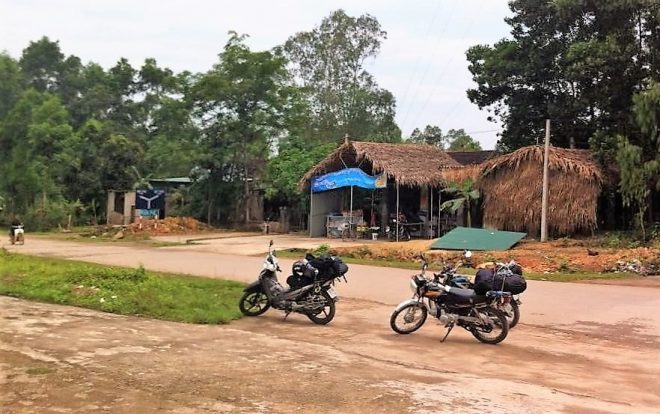
The good part about buying a bike is that you can re-sell it again at the end of your trip and essentially make your money back. The bad part? You could end up with a bike that’s got some mechanical issues and there’s no “return policy” – you just hand over the cash and the deal is done.
My advice: don’t buy a bike without test driving it first. If possible, take it to a repair shop with the seller to get a mechanics opinion.
Renting a motorbike in Vietnam: If you can’t find a decent bike, the other option is to rent. Visit a few bike shops and ask if they’d agree to a long-term rental and allow you to return the bike in a different location. Shop around and haggle your best price. The good part about renting is the bike you get will typically be in acceptable working order. The bad part? You can’t sell it and make your money back.
How much should I pay?
The price of buying a motorbike depends on its condition and age. My travel partners both bought old, but relatively well-functioning Honda Waves and spent around $250 each. At the end of the trip, they sold them for the same amount they’d paid for them.
I didn’t find a bike to buy in time, so I found a shop in Hanoi willing to rent me one. I signed a contract agreeing to return it to their “sister” shop in Ho Chi Minh, paid around $300 USD, and gave a photocopy of my passport.
At first, they wanted to keep my original passport, promising to send it to whichever hostel I stayed at in Ho Chi Minh. DON’T AGREE TO THIS. Your passport is your identification and ticket out of the country. Never give it up to anyone other than maybe the hostel/guesthouse receptionist.
Hit the road
You’ve got your buddies and your bike and now it’s time to hit the road.
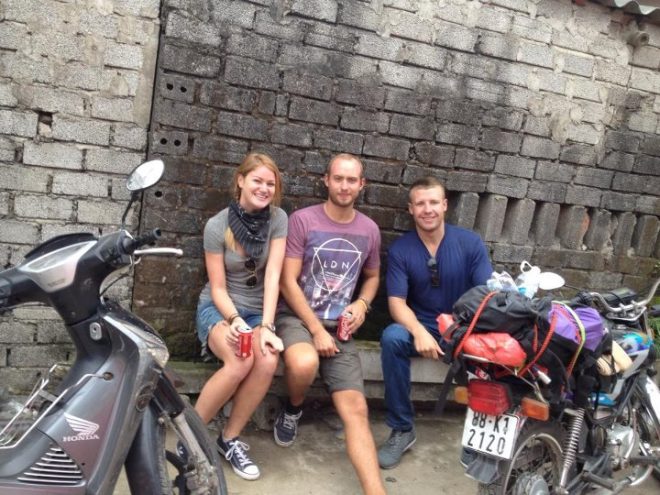
Look at a map and decide where you want to stop along the way. Most of the must-see cities are conveniently located within a day’s drive from one another. Some legs are more than 250 kilometers which is tiring to complete in one day.
In this case, just pick a random town and have a stop-over night there. This is actually a really fun way to see Vietnam’s two faces; the totally random and undeveloped towns that have seen very few foreigners stand in stark contrast to the popular cities equipped for travelers and backpackers.
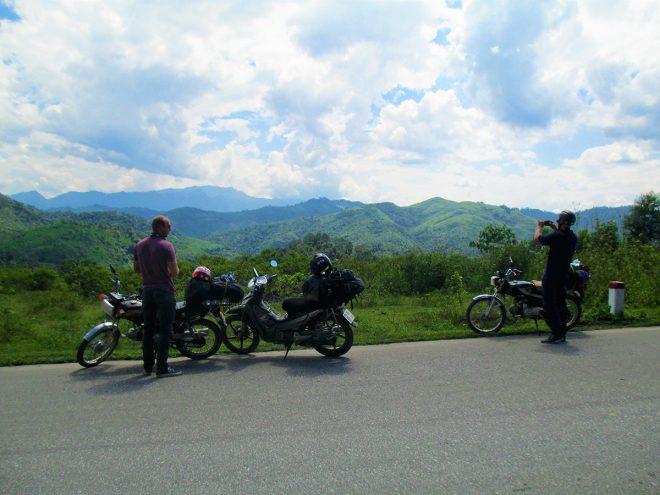
Motorbiking route for Vietnam
The itinerary below starts in Hanoi and finishes in Ho Chi Minh (north to south), but remember, you can always reverse it and go south to north.
Factor in a few nights in each of the destinations listed below which will give you enough time to check out the main attractions.
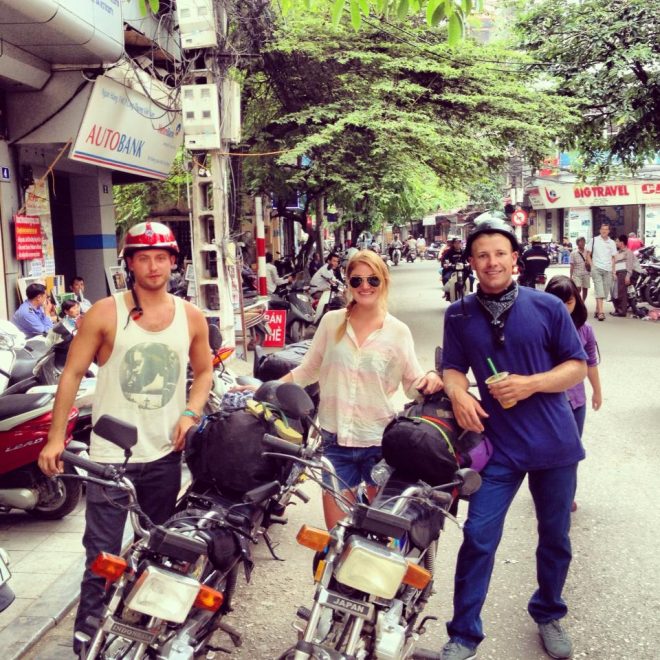
Itinerary Overview
- Total trip distance from Hanoi to HCM: roughly 1,845 kilometers (1,146 miles)
- Total duration: 21 days (or longer if you’ve got more time)
- Destinations: 10
- Starting point: Hanoi
- First stop: Ninh Binh,105km – take a boat ride around Van Long Nature Reserve.
- Second stop: Vinh, 201km – visit Cua Lo Beach or daytrip to Doi Che’s Green TeaIslands.
- Third stop: Phong Nha Ke Bang National Park, 195km – Explore the National Park’s magnificent caves. The vistas from the roads leading into and out of the park are absolutely stunning, too!
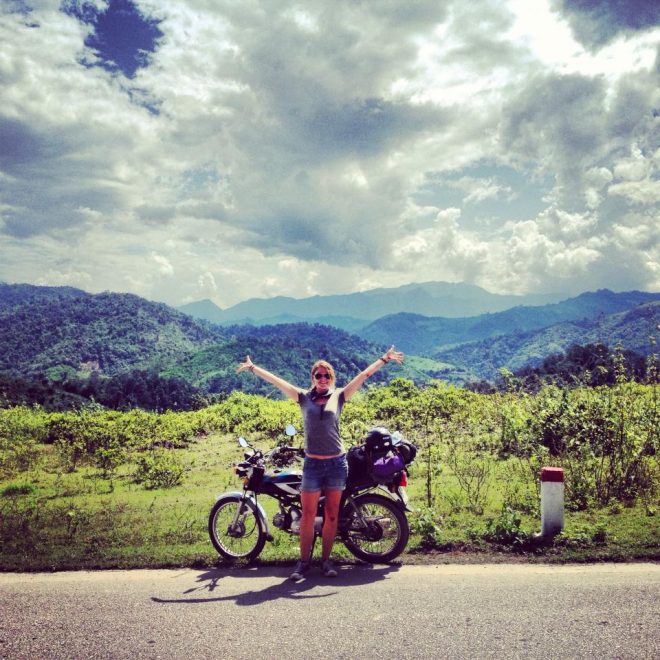
- Fourth stop: Hue, 210km -check out the Imperial Citadel and the Thien Mu Pagoda.
- Fifth stop: Hai Van Pass to Hoi An, 131km – stroll around the UNESCO-listed Old Town and get something tailor-made. Make time to lounge on nearby Cua Dai Beach.
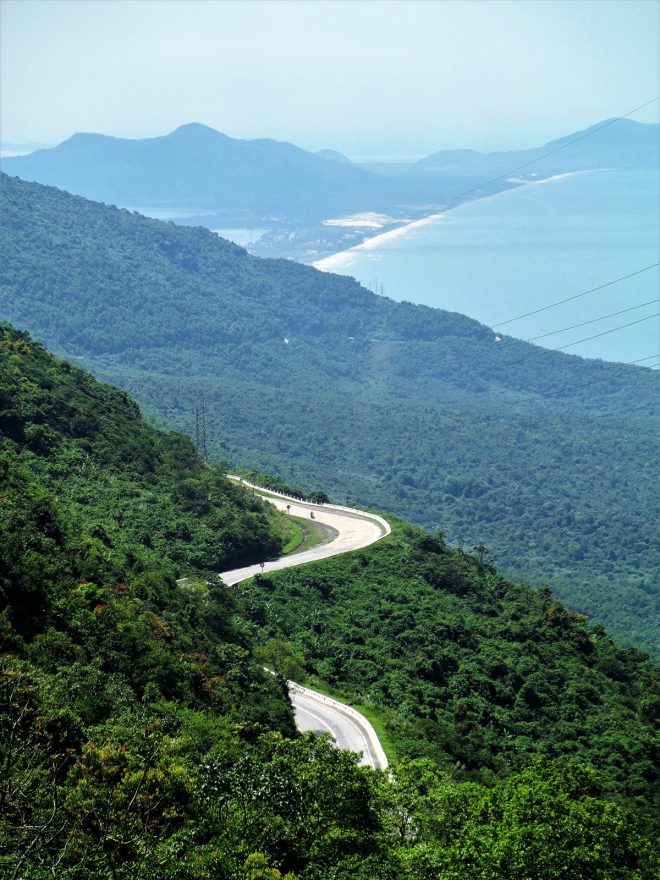
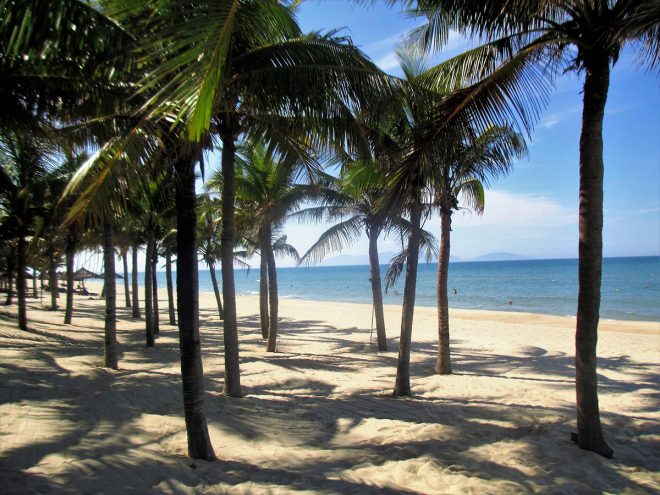
(It’s a long haul between Hoi An and Nha Trang – plan the sixth stop somewhere in between).
- Seventh stop: Nha Trang, 500km– relax at the Thao Ba Hot Springs and Mud Bath,chill out on Nha Trang Beach and people watch, and visit the ancient Po Nagar Towers.
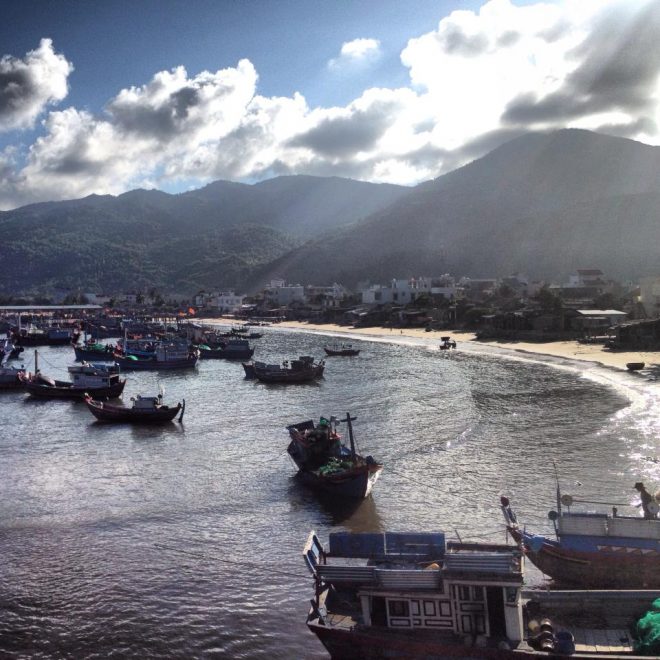
- Eighth stop: Dalat, 134km – eat your way around the night market, creep around the Crazy House, and wander the serene Xuan Huong Lake. Stop by the epic Pongour Waterfall on your way out of town.
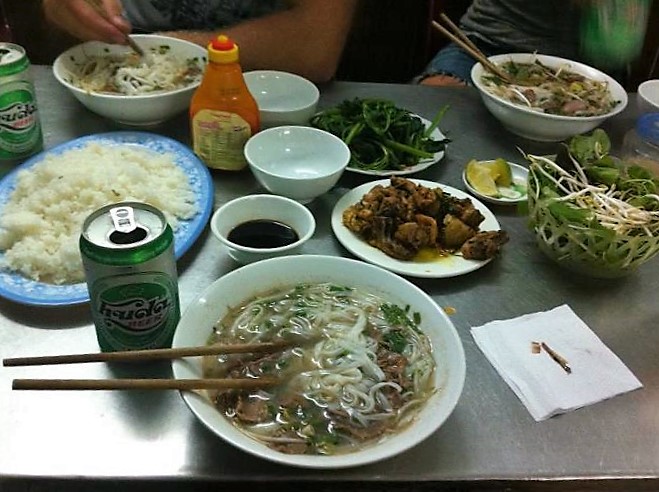

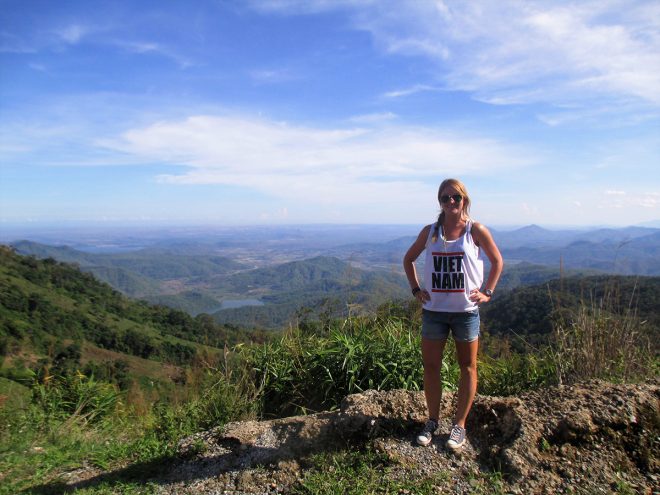
- Ninth stop: Mui Ne, 154km – kitesurf the choppy seas and 4-wheel around the famous red and white sand dunes. Fairy Steam is another must-see.

- Tenth stop: Ho Chi Minh, 215km – crawl through the Cu Chi Tunnels and make a sobering stop at the War Remnants Museum.
Now, the most important part…
Driving in Vietnam tips & advice
Your great Vietnam expedition doesn’t come without its risks. These tips and advice will help to prepare you for life on the road, ensuring smooth sailing the whole way.
- Traffic in Vietnam is mental, especially in Hanoi and Ho Chi Minh. The never-end swarm of motorbikes can intimidate even experienced riders. The best way to overcome traffic fears here is to go with the flow. Literally. Take your cues from the local drivers.
- Don’t hesitate when inching into traffic. The locals possess extremely impressive manoeuvring skills. Although it doesn’t look like it, there seems to be an unwritten rule between bikers and they’ll almost always yield or swoop around you at the last second.
- Road conditions in Vietnam vary. Sometimes you’ll find well-paved roads or dusty 6-lane highways. You might also stumble onto some muddy backroads. Always proceed with caution.
- Other drivers can slam on the breaks or veer off the road without a moment’s notice. Keep a good distance between you and the vehicle in front of you and STAY ALERT. We adjusted our speed and paid closer attention to the road after we saw an accident where a motorbike was wedged under the front wheels of an 18-wheeler.
- Watch out for animals on the road. I fell off my bike swerving around a man walking his cow. Yes, really.
- Don’t make eye contact with police. They’re known to pull over foreigners on motorbikes and force them to pay “fines” (bribes) for driving without an International License or riding a bike that’s not registered to them. We cleared one checkpoint without being stopped by literally pretending we didn’t see the officers. I don’t know if that’s good advice or not, but it worked for us.
- English isn’t widely spoken outside of the touristy areas. However, all the people we encountered on the road were friendly and tried their best to communicate. Don’t be shy – everyone was curious and happy to snap pictures with us.
- Ask for help if you need it, especially during a breakdown. Locals helped us fix our bikes on two separate occasions. It’s a good thing they were so willing to help; both times we were in middle of nowhere without a car garage in sight. The kindness of these locals totally saved the day. All for about $5.
Vietnam impresses regardless of your method of travel, but the experience is much more fulfilling if you discover it by motorbike. It’s true that Vietnam’s popularity is creating a country that’s more and more catered towards young backpackers who like to party, play, and eat for cheap. But if you leave those travelers behind, hop on your bike, and take off into the unknown, there’s an unforgettable adventure waiting for you.
Some links may be affiliate links, meaning I may earn commission from products or services I recommend. For more, see site policies.
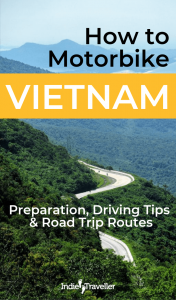
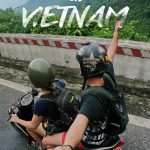
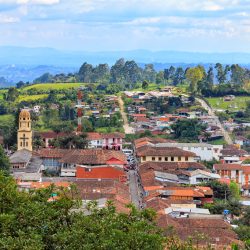
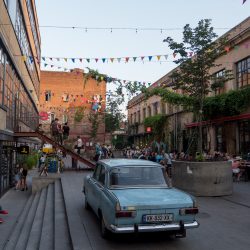




Hi Fiona, great tips on Vietnam, many thanks! My girlfriend and I want to have the same experience exploring Vietnam by motorbike, but hardly have any experience driving a motorbike. On other blogs people recommend joining a group of easy riders, like https://www.easyridersvietnam.org/ – did you consider this?
Did you have any experience driving a motorcycle before going to Vietnam?
Hi Kieren,
I did have 6 months experience driving a semi auto in Thailand which definitely helped in terms of confidence and feeling familiar with the fast pace! I’d definitely recommend some practice first as the roads can be a bit intimidating for a first timer!